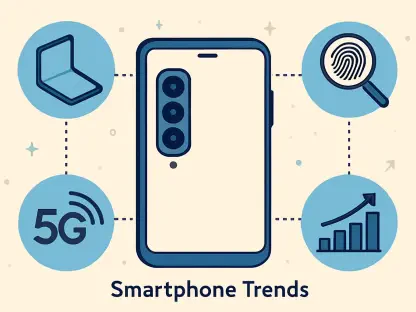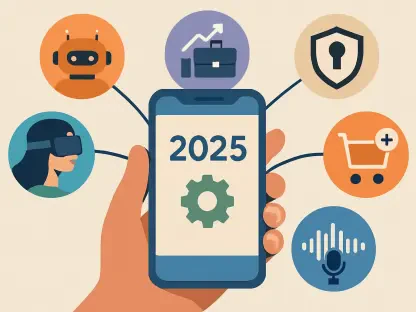The smartphone industry is in a constant state of evolution, particularly when it comes to enhancing security measures and integrating advanced artificial intelligence (AI) functionalities. Recently, Google has introduced significant security updates for Android devices, addressing major concerns around theft protection. Meanwhile, Apple is gearing up to launch a suite of AI-based features for its iPhone 16 series, collectively referred to as Apple Intelligence. Both tech giants are setting the stage for a new era in smartphone technology.
Google’s Comprehensive Security Enhancements for Android
Google has tackled security vulnerabilities head-on with its latest update for Android devices, introducing three groundbreaking features to thwart theft and enhance user data protection. One of the standout features is the Theft Detection Lock, which automatically locks a device when it detects forcible seizure, rendering the phone inaccessible to thieves. This real-time defensive measure aims to secure the device at the moment of theft, significantly disrupting unauthorized access. Complementing this, the Offline Device Lock nullifies tactics that rely on disconnecting phones from the internet to avoid remote locking capabilities.
The Offline Device Lock ensures that users can lock their phones even without internet connectivity, thereby securing stolen devices irrespective of internet status. The Remote Lock feature adds another layer of flexibility, allowing users to remotely lock their phones without needing to log into their Google account. By using a phone number and a security question, users gain a versatile method to secure their devices when traditional internet-based methods are unavailable. These innovations collectively aim to address the prevalent issue of smartphone theft by instituting robust security mechanisms that safeguard user data and device integrity.
Apple’s AI Revolution: Introduction of Apple Intelligence
Apple is not lagging behind in the race, as it prepares to roll out Apple Intelligence for its newly launched iPhone 16 series. Although these AI advancements were not available at launch, they are scheduled to begin with iOS 18.1, which will be available from October 28. Apple Intelligence is designed to imbue iPhones with advanced AI capabilities, streamlining everyday tasks and enhancing user interactions. One of the practical applications includes notification summarization, which aims to make user interactions more efficient by condensing information into easily digestible formats.
Another key feature is the enhanced Siri functionality, which not only understands spoken commands but also becomes more adept at interpreting verbal nuances. This phased rollout strategy emphasizes a methodical approach, introducing initial features first and gradually adding more sophisticated capabilities over time. This allows users to adapt to changes progressively while enabling Apple to gather user feedback and refine these AI functionalities incrementally. By doing so, Apple ensures that these innovations are implemented smoothly and evolve based on real-world utilization and user interactions.
The Emphasis on Robust Security Measures
The updates from both Google and Apple underscore a shared priority: enhancing smartphone security to protect user data against increasingly sophisticated threats. Google’s latest security features—Theft Detection Lock, Offline Device Lock, and Remote Lock—address pressing concerns related to smartphone theft, providing users with multiple layers of protection. These updates highlight Google’s commitment to reinforcing user security through technology. Each of these features serves to close pre-existing security loopholes, making it notably harder for thieves to access stolen devices.
Similarly, Apple’s AI-driven Apple Intelligence is developed to intuitively manage tasks and secure user data, emphasizing the significance of these capabilities in modern smartphones. By leveraging AI, Apple aims to offer practical, user-centric improvements that extend beyond typical operational efficiencies to address security concerns. The sophisticated AI integrations work in the background to enhance user experiences while safeguarding personal information. Together, these renewed focus areas show how both tech companies are dedicated to elevating the security standards and ensuring user trust in their devices.
Phased Rollout: A Strategic Approach
Both tech giants have adopted a phased approach for their new features, enabling a gradual adaptation and iterative improvement based on user feedback. For Google, rolling out comprehensive security features in phases ensures smooth transition and broad user acceptance. The multiple layers of security provide versatile solutions for different theft and loss scenarios, establishing an enhanced security ecosystem for Android. The phased strategy allows Google to meticulously test each feature, gather data on its effectiveness, and make necessary adjustments.
Apple’s staggered introduction of Apple Intelligence allows for meticulous refinement and customization based on real-world usage. This strategy not only ensures ease of use but also allows Apple to optimize the AI functionalities for a seamless user experience. By gradually rolling out updates, Apple can better manage user expectations and troubleshoot any issues that may arise. The ultimate goal is to provide users with innovative features that are both reliable and adaptable, ensuring that these advancements truly enhance the smartphone experience.
AI Integration for Enhanced User Experience
The integration of AI into smartphones represents a significant trend toward creating more intuitive and personalized user experiences. Apple’s Apple Intelligence aims to set a new benchmark for AI integration within mobile technology. Features that aid in summarizing notifications and improving Siri’s comprehension of spoken commands highlight Apple’s objective to enhance everyday user interactions. These advancements reflect both companies’ commitment to leveraging AI for practical, user-centric improvements that elevate the overall efficiency and usability of smartphones.
AI functionalities incorporated into devices are designed not just for novelty but to solve real-world problems and improve daily tasks. Both Google and Apple’s enhancements indicate a clear trajectory toward smarter, more responsive, and more secure smartphones. These technological strides aim to integrate seamlessly into users’ lives, making interactions with devices more natural and intuitive. The focus is on enhancing efficiency while maintaining stringent security standards to protect users’ valuable data.
Setting New Standards in Smartphone Technology
The smartphone industry is perpetually evolving, especially in the realms of security enhancements and advanced AI functionalities. Recently, Google unveiled major security updates for Android devices, focusing on theft protection and addressing significant security concerns. These updates aim to fortify the devices against unauthorized access and improve overall user safety. On the other hand, Apple is preparing to introduce a new suite of AI-based features for its upcoming iPhone 16 series, under the collective moniker of Apple Intelligence. This initiative seeks to integrate machine learning and AI capabilities more deeply into the user experience, enhancing functionalities like Siri, camera performance, and predictive text. Both industry leaders are paving the way for a new era in smartphone technology, setting high standards in both security and innovative features. Their advancements highlight the importance of integrating cutting-edge technology to meet contemporary user demands and ensure a safer, more intuitive smartphone experience. These efforts signify a crucial leap forward in the ever-changing landscape of mobile technology.









